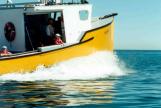20
While the area's infrastructure, economy and culture were modernizing mid-century, preparing the ground for the technological revolutions in fishing that were just around the corner, a group of boat builders was quietly making the area famous for an old-fashioned trade: wooden boat building. Dave Forgeron, Dan McDougall, Gerald Gallant, and John Hall were fishermen and boat builders whose names resonate in Cape Breton fishing communities with the kind of reverence usually reserved for the master artists of the Renaissance.Except for gathering the wood and putting on the planks, which required the help of at least one other man, most of the work of boat building, of making the raw wood into a vessel - the way a composer might turn freely available musical notes into a symphony - was done alone, usually in a small boathouse in the back of the builder's property.
From this shack, each builder might roll out one or two boats every one or two years, producing over his lifetime as many as one hundred! As the fishing season neared, though, and as the boat builder's work neared completion, builder and boat alike began inching their way toward the sea.
The rather stunning physical output was only part of each man's legacy: more-over it was the artistry and care of the work - what you might call the craft of the craft - such that fishermen today, who mainly prefer the superior durability of fibreglass over wooden boats, would gladly decorate their living rooms with one of these handmade creations. And while part of improving his trade meant that each of the builder's boats was different from the last, every fishermen on the wharf could tell, just by looking, which boat was built by which man.
After the fishing season and come Fall, the boat builder began anew. He'd begin planning his next boat, first in his head, then perhaps by whittling a miniature model out of wood, or producing a detailed schematic.
With plans in place, the builder selects the hardwood (most likely maple) for the keel (a beam around which the hull is built, essentially the boat's backbone); the forefoot (where the bow meets the keel); and the stern post. He shapes these elements, bolts them together into a skeletal frame, and drills a pine dowel through the splice to prevent water from seeping into the boat. A mould is put in place, which gives the boat its shape, and which will be removed after the boat is planked.
Steam is used to soften the timber beams and make them malleable enough to bend and shape.
Planking follows, which consists of wide pine live-sawed boards which are cut, shaped, and nailed onto the oak timbers.
The moulds are removed and reinforcements put in to strengthen the boat.
The planks are sanded and the seams corked with a cotton-like fibre, and then epoxy is put in the seams over the corking to make the plank seamless.
Floor beams and bulk-heads are next.
Then comes the enclosed wheelhouse, or fore house - a recent innovation, given that the boats of yesterday were wide-open, neither the protective windbreaker nor shelter that nowadays can range from a cubby hole to a small apartment. In the old days, all the fishermen might have had to warm himself was a little stove that he kept aboard for a nice hot cup of strong tea, alongside a bun of homemade bread, smothered in rib-sticking molasses. "No fancy stuff," an old fisherman declares.
After spot-checking, painting, and outfitting the boat for safety, the vessel is given a name. This can range from the profound to the profane, often referencing the area, the type of fish the boat will be used to catch, or the captain's favourite fisherman's saying. Many name their boats after family members - sons, daughters, wives, whoever's name has the most pun value! All of which speaks to the fact that the culture of fishing, and the fisherman's love for it, both go as deep into the man as into his past.
The unofficial last step is to rest, unwind, and spend time with family, and with friends.
Come Spring, thanks to the efforts of the builder, a new boat would be on the water; and the boat builder himself, his belt one notch lighter, would be right behind it.
